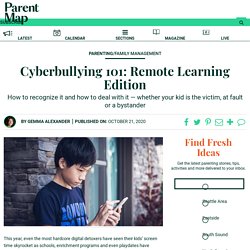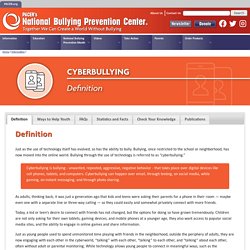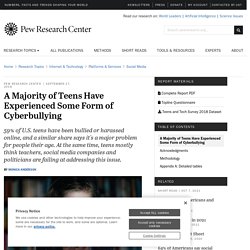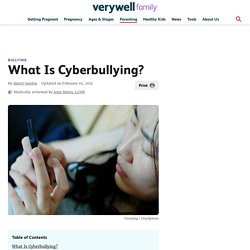

Cyber-bullying Facts – Top 10 Forms of Cyber Bullying. When harassment and intimidation take place online, it’s called cyberbullying.

This kind of bullying can be especially hard to deal with, since it can be difficult to control and visible to a large number of people. Chances are your child spends a lot of time online, so it’s important to make sure you know what to do if online behaviour gets nasty. 4 Important Ways Teachers Can Stop Cyberbullying. Remember the Burn Book in the movie Mean Girls?

A group of “popular” high school girls would cut out pictures of their peers from yearbooks, write dirt and gossip about them in the book, and then pass it around. It was mean, petty, dangerous, and I used to think it was totally unrealistic. Then I became a teacher and realized that this kind of thing happens more often than you think. It is an epidemic that leads to self-harm, growing suicide rates, and an increasing number of kids with anxiety and depression. Here’s the difference, though. Just this week one of my students was the target of cyberbullying. One of our most important jobs as teachers is to ensure the safety of our students. 1. Teachers hold a captive audience, and what we say has a tremendous impact on our students. Hold class discussions about it. 2. The internet is still fairly new, and therefore cyberbullying is also a recent issue.
A great avenue to start these conversations with parents is through your administration. Cyberbullying 101: Remote Learning Edition. This year, even the most hardcore digital detoxers have seen their kids’ screen time skyrocket as schools, enrichment programs and even playdates have moved online to help prevent the spread of the coronavirus.

Now that keeping our kids and ourselves physically safe requires spending so much time online, the question becomes, how do we keep our kids safe in cyberspace? In the past, parents’ primary concern was keeping teens safe from online predators, but now that kids — even very young ones — are going to school online, more parents are starting to worry about cyberbullying. “There just hasn’t been enough opportunity to do much solid research on distance learning, but because kids are spending so much more time online, it increases the opportunity to have these hurtful behaviors happen,” says Julie Hertzog, director of PACER’s National Bullying Prevention Center.
Media Violence and Children: A Complete Guide for Parents and Professionals, 2nd Edition (ADVANCES IN APPLIED DEVELOPMENTAL PSYCHOLOGY): Gentile, Douglas A.: 9781440830174: Amazon.com: Books. Cyberbullying - National Bullying Prevention Center. Just as the use of technology itself has evolved, so has the ability to bully.

Bullying, once restricted to the school or neighborhood, has now moved into the online world. Bullying through the use of technology is referred to as “cyberbullying.” Cyberbullying is the use of technology to repeatedly and intentionally harass, hurt, embarrass, humiliate, or intimidate another person. As adults, thinking back, it was just a generation ago that kids and teens were asking their parents for a phone in their room — maybe even one with a separate line or three-way calling — so they could easily and somewhat privately connect with more friends. Today, a kid or teen’s desire to connect with friends has not changed, but the options for doing so have grown tremendously. Cyberbullying can happen anywhere there is online social interaction. Cyberbullying: Definition and Dynamics 1. electronic forms of contact 2. an aggressive act 3. intent 4. repetition 5. harm to the target (Hutson, 2016 )
Cyberbullying Identification Prevention Response 2018. A Majority of Teens Have Experienced Some Form of Cyberbullying. Name-calling and rumor-spreading have long been an unpleasant and challenging aspect of adolescent life.

But the proliferation of smartphones and the rise of social media has transformed where, when and how bullying takes place. A new Pew Research Center survey finds that 59% of U.S. teens have personally experienced at least one of six types of abusive online behaviors. The most common type of harassment youth encounter online is name-calling. Some 42% of teens say they have been called offensive names online or via their cellphone. Additionally, about a third (32%) of teens say someone has spread false rumors about them on the internet, while smaller shares have had someone other than a parent constantly ask where they are, who they’re with or what they’re doing (21%) or have been the target of physical threats online (16%). The vast majority of teens (90% in this case) believe online harassment is a problem that affects people their age, and 63% say this is a major problem. What Is Cyberbullying? What Is Cyberbullying?

When a young person uses the Internet or technology to harass, threaten, embarrass, or target another person, this person is called a cyberbully.1 Typically, cyberbullying involves tweens and teens; but it's not uncommon for adults to experience cyberbullying and public shaming as well. Compared to traditional bullying, the effects of cyberbullying are often more significant. Not only do the hurtful messages reach an unlimited audience, but the words and images are often preserved online.2 Even if someone deletes a mean post, chances are it's still available in some form such as in a screenshot or a shared text message.
Worse yet, those targeted by cyberbullies often don't know who is bullying them, so they often have no way to bring it to an end. 11 Facts About Cyberbullying. What is Cyberbullying? “What is Cyberbullying?”

Is one of the most frequent questions we are asked because many know what it is when it happens, but have trouble wrapping succinct descriptive words around it.